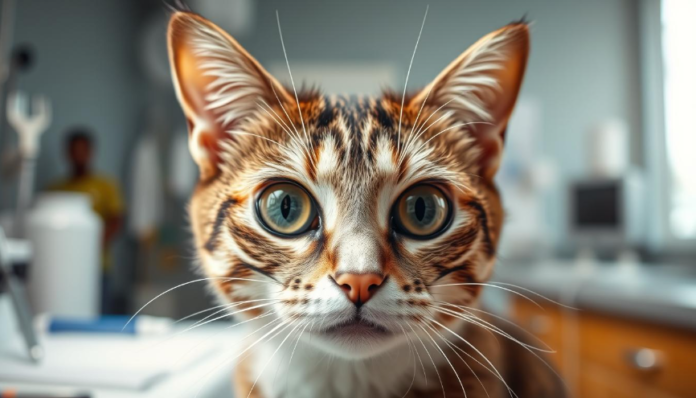Glaucoma in Cats As a devoted cat parent, the thought of your feline companion’s vision deteriorating due to a serious eye condition like glaucoma can be truly heartbreaking. However, with the right information and proactive care, you can play a vital role in preserving your cat’s eye health and protecting their quality of life. In this comprehensive guide, we’ll explore the intricacies of glaucoma in cats. We’ll equip you with the knowledge to recognize the signs, understand the available treatments, and take preventive measures to safeguard your beloved pet’s vision.
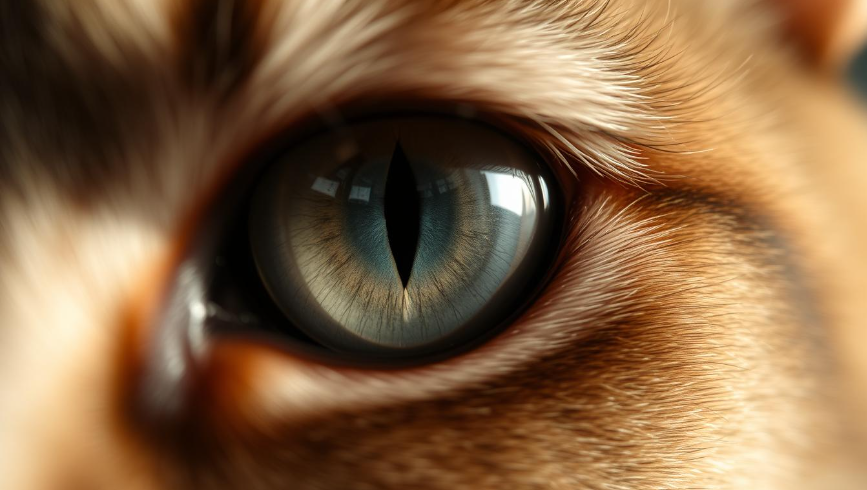
Key Takeaways
- Glaucoma is a serious eye condition in cats that can lead to irreversible vision loss if left untreated.
- The condition is caused by an increase in intraocular pressure, which can damage the optic nerve and impair your cat’s sight.
- Early detection and prompt treatment are crucial to managing feline glaucoma and preserving your cat’s vision.
- Certain breeds and health conditions may put cats at a higher risk of developing glaucoma.
- Regular eye exams and proactive care can help prevent or manage glaucoma in your feline friend.
Understanding Glaucoma in Feline Companions
As pet owners, it’s vital to know about glaucoma in cats. This eye disease can be serious if not treated. It happens when intraocular pressure (IOP) in the eye gets too high. This can damage the optic nerve and cause vision loss in cats.
What is Glaucoma?
Feline glaucoma happens when fluid in the eye can’t flow right. This causes pressure to build up. The high pressure can harm the eye’s delicate parts, like the optic nerve. This nerve sends visual info to the brain.
Causes of Glaucoma in Cats
Glaucoma in cats can be caused by many things. It might be due to how the eye develops, health issues, or eye injuries. These can stop fluid from draining properly. This leads to high intraocular pressure, a key sign of the disease.
“Glaucoma is a silent thief of sight, and early detection is crucial for preserving vision in affected cats.”
Knowing about glaucoma in cats is key. It helps us give our cats the care they need. This keeps their eyes healthy and their vision sharp.
Recognizing the Signs of Feline Glaucoma
As pet owners, it’s important to watch for early signs of glaucoma in cats. This disease can cause vision loss and blindness if not treated. Knowing the symptoms helps cat parents act fast to care for their pets.
A common sign is redness or swelling in the eye. The eye might look watery or tear a lot. Cats with glaucoma may also be sensitive to light, squint, or show signs of eye pain.
“Recognizing the early signs of glaucoma in cats is essential for timely diagnosis and effective treatment.”
Look for changes in your cat’s behavior too. They might seem reluctant to engage in daily activities or show vision loss. If they have trouble navigating or seem hesitant to jump, it could be a sign of glaucoma.
If you notice these symptoms, see a vet right away. Early treatment can help manage eye pressure and save their vision.
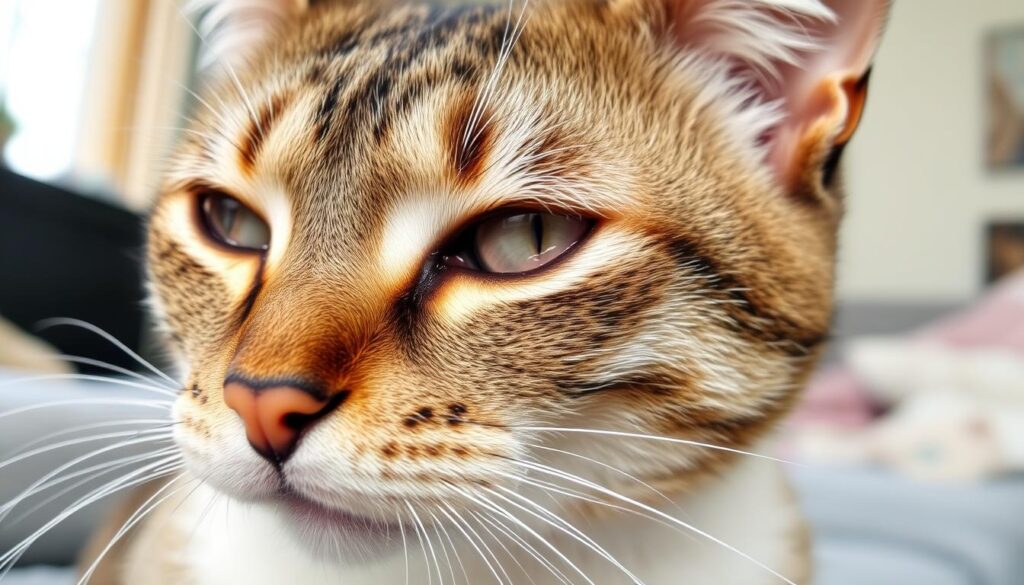
By being alert and knowing the signs of feline glaucoma, pet owners can get their cats the care they need. This helps keep their eyes healthy and their overall well-being.
Risk Factors for Glaucoma in Cats
Glaucoma can hit any cat, but some breeds are at higher risk. Age and health problems also play a part in who gets glaucoma.
Breed Predisposition
Siamese and Burmese cats are more likely to get glaucoma. They often have eye drainage issues. This leads to fluid buildup and high eye pressure. Keeping a close eye on these cats and acting fast is key.
Age and Health Conditions
Older cats face a higher glaucoma risk. Cats over 7 are especially at risk. Health issues like diabetes or lens problems can also lead to glaucoma.
Regular vet visits and eye checks are vital. They help spot glaucoma early. Knowing the risks helps cat owners and vets keep their pets healthy.
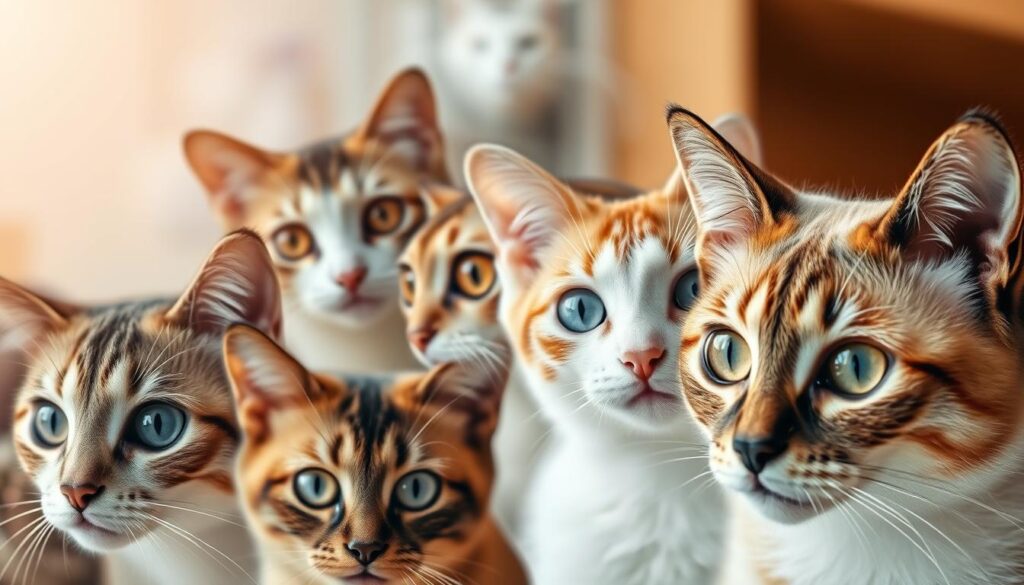
“Vigilant monitoring and early intervention are crucial for managing glaucoma in predisposed breeds.”
Glaucoma in Cats: Signs, Treatment, and Prevention
Glaucoma in cats, also known as feline glaucoma, is a serious eye condition. It can lead to vision loss if not managed properly. This disease is progressive and increases eye pressure, damaging the optic nerve and impairing vision.
The signs of glaucoma in cats can be subtle. It’s important for pet owners to be vigilant. Common symptoms include redness, squinting, and a cloudy or enlarged eye. In severe cases, vision loss in cats may occur. Prompt diagnosis and treatment are crucial to preserve a cat’s sight and prevent further damage.
Treating Feline Glaucoma
The treatment for glaucoma in cats involves medication and sometimes surgery. Medications, such as eye drops, are often the first line of defense. They aim to reduce eye pressure in cats and manage the condition.
In more advanced cases, surgical options may be considered. These include procedures to improve fluid drainage or reduce fluid production in the eye. These treatments can alleviate symptoms and slow disease progression.
Preventing Glaucoma in Cats
While some forms of feline glaucoma may be hereditary or occur due to other health conditions, there are steps pet owners can take to help prevent it. Regular eye exams are essential. They can detect glaucoma in cats in its early stages, allowing for timely intervention.
- Monitoring for signs of eye issues, such as redness, squinting, or a cloudy appearance
- Ensuring cats receive proper veterinary care, including routine check-ups and any necessary treatments
- Providing a safe, stress-free environment to support overall feline health and well-being
By understanding the signs, treatment options, and preventive measures for glaucoma in cats, pet owners can play a vital role. They can safeguard the vision and overall health of their feline companions.
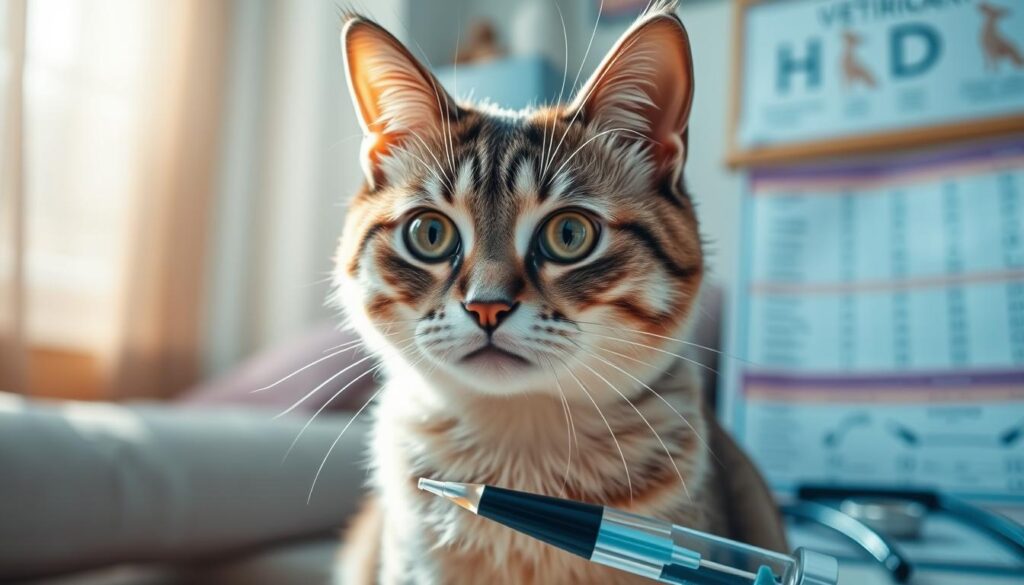
Diagnostic Tests for Feline Glaucoma
To diagnose glaucoma in cats, a detailed eye check and precise pressure measurement are needed. These tests, done by a skilled vet, help find the cause and plan treatment.
Eye Examination
The eye check is key in finding glaucoma in cats. The vet will look at the cat’s eyes closely. They check the structure, function, and health of the eye. This detailed eye examination includes:
- Checking the cornea, pupil, and other eye parts
- Looking at the optic nerve and retina with special tools
- Examining the eye’s inside, like the lens and vitreous humor
Intraocular Pressure Measurement
Measuring intraocular pressure is also important for glaucoma in cats. This test, called tonometry, checks the eye’s pressure without hurting the cat. High pressure is a sign of glaucoma.
“Accurate diagnosis of glaucoma in cats is vital for determining the appropriate treatment and management plan.”
By doing a detailed eye check and measuring pressure, vets can spot glaucoma in cats. This helps start the right treatment and care for this serious eye problem.
Treatment Options for Glaucoma in Cats
Managing glaucoma in cats often requires a mix of treatments. Veterinarians might suggest medication and surgery to lower eye pressure. This helps treat the condition and its cause.
Medication Management
Medications are a key part of treating glaucoma in cats. Eye drops or pills help lower eye pressure. Common treatments include:
- Prostaglandin analogs, such as latanoprost or bimatoprost, which help to increase the drainage of fluid from the eye
- Beta-blockers, like timolol, which reduce the production of aqueous humor
- Carbonic anhydrase inhibitors, such as dorzolamide or brinzolamide, which also decrease fluid production
It’s important to manage these medications carefully. They need to be given regularly and correctly to work well.
Surgical Interventions
For some cats, surgery is needed when medicine alone isn’t enough. Surgical options include:
- Trabeculectomy: A procedure that creates a new drainage pathway for the eye’s fluid, allowing for improved outflow and reduced pressure
- Gonioimplants: The insertion of small devices that help enhance fluid drainage and lower intraocular pressure
- Cyclophotocoagulation: A laser-based treatment that reduces the production of aqueous humor, the fluid that can build up and cause pressure
These surgeries are for more serious cases where medicine doesn’t help enough.
The right treatment for a cat with glaucoma depends on the situation. Working closely with the vet is key to managing this condition well.
Managing Glaucoma in Cats: Ongoing Care
Managing glaucoma in cats needs regular vet visits and close eye checks. These are key to tracking the disease and adjusting treatments as needed.
It’s vital to stick to the treatment plan to keep eye pressure stable. Owners must give eye drops or pills exactly as the vet says. Skipping doses or changing meds too fast can harm the cat’s vision.
As the cat’s condition changes, the treatment might need to change too. Vets might adjust meds, add new ones, or suggest surgery if needed.
“Managing glaucoma in cats requires a collaborative effort between the veterinarian and the pet owner. With proper ongoing care and vigilance, we can help cats with glaucoma maintain their quality of life and preserve their precious vision.”
Regular vet visits help track how well the treatment is working. Owners should tell the vet about any changes in their cat’s behavior or eyes.
By following through with the care needed for glaucoma, cat owners can help their pets stay healthy. This ensures their feline eye health is protected for as long as possible.
Preventive Measures for Feline Glaucoma
While glaucoma in cats can’t always be stopped, there are steps to lower the risk. These include regular eye exams and watching for lifestyle and environmental factors. These can help prevent glaucoma and catch it early.
Regular Eye Exams
Getting your cat to regular eye exams is key. A vet can spot glaucoma early and start treatment. Even if your cat seems fine, yearly eye checks are a must.
Lifestyle and Environmental Factors
Watching your cat’s lifestyle and environment is also important. Keep them at a healthy weight and give them fun activities. Avoiding eye injuries and infections can also help.
By being proactive, you can help prevent glaucoma in your cat. This keeps their eyes healthy and their vision clear for years to come.
Coping with Vision Loss in Cats
When cats lose their vision due to glaucoma, it’s tough for both the cat and the owner. But, with the right support and changes, cats can still live well. They can keep a good quality of life, even with feline eye health issues.
To help a cat with vision loss, make their home safe and familiar. Move furniture carefully and keep things the same. Use bright lights and clear contrasts to help them see better.
- Make routines and cues clear, like using specific commands or walking patterns.
- Introduce new things slowly, letting your cat get used to them.
- Keep your home safe from dangers, like sharp edges or drops.
Also, try these tips to help your cat feel better:
- Play with toys that use their other senses, like touch or sound.
- Give them a safe outdoor space, like a catio, for exercise.
- Get help from a vet or animal behaviorist to make a care plan for your cat’s glaucoma in cats and vision loss.
“With patience, adaptations, and a loving environment, cats can thrive despite vision loss. Their resilience and ability to adapt are truly remarkable.”
By focusing on your cat’s safety, comfort, and happiness, you can help them deal with vision loss in cats. They can still have a happy and full life.
Feline Eye Health: Beyond Glaucoma
While glaucoma is a big worry for cat owners, it’s not the only eye problem. Cats can face many eye issues, from cat eye diseases to different eye conditions in cats. It’s key to understand the importance of eye care for our pets’ health and happiness.
Conjunctivitis is a common eye issue in cats. It’s an inflammation of the thin membrane covering the eye. It can be caused by allergies, infections, or irritants. Quick treatment with eye drops or ointments is needed to ease pain and prevent more problems.
Cats can also get cataracts, which can make their vision worse over time. This condition is often linked to aging but can also be caused by health issues like diabetes. Regular vet visits and quick treatment can help manage cataracts and keep your cat’s vision sharp.
Uveitis is another concern, an inflammation of the middle layer of the eye. It can be caused by infections, injuries, or autoimmune disorders. If not treated, it can cause permanent vision loss. Quick diagnosis and treatment, like medication and addressing the cause, are vital for managing uveitis in cats.
“Maintaining your cat’s eye health is essential for their overall well-being and quality of life.”
Regular vet visits and proactive prevention are crucial for feline eye health. By being alert and addressing eye issues quickly, you can help your cat keep their vision and live a happy, healthy life.
Conclusion
Glaucoma is a serious eye condition that can harm our cats’ health. As pet owners, it’s important to know the signs, causes, and treatments for glaucoma in cats. This knowledge helps protect our pets’ vision and keeps them healthy.
Early detection and treatment, like medication and surgery, can slow down feline glaucoma. Regular eye checks and watching for changes in behavior or sight help catch the problem early. This way, we can act fast to help our cats.
Being proactive about glaucoma in cats makes us better caregivers for our pets. We can help our cats live better lives by facing this condition together. Our goal is to keep them comfortable, safe, and happy.
FAQ
What is glaucoma in cats?
Glaucoma in cats is when the eye pressure goes up. This can harm the optic nerve. It can cause cats to lose their vision.
What causes glaucoma in cats?
Glaucoma in cats can be caused by several things. These include genetic issues, health problems, and eye injuries.
What are the symptoms of glaucoma in cats?
Cats with glaucoma may show signs like red eyes and lots of tears. They might also be sensitive to light and show pain.
Which cat breeds are predisposed to glaucoma?
Some cat breeds, like Siamese and Burmese, are more likely to get glaucoma. This is because of their genes.
What risk factors increase the likelihood of glaucoma in cats?
Older cats and those with health issues like diabetes are more at risk. So are cats with certain eye problems.
How is glaucoma diagnosed in cats?
A vet will do a detailed eye check and measure the eye pressure. A specialist in eye care will do this.
What are the treatment options for glaucoma in cats?
Treatment for glaucoma depends on the case. It might include medicine or surgery. The vet will decide what’s best.
How can I help manage glaucoma in my cat?
Managing glaucoma means regular vet visits and following the treatment plan. This helps keep the condition under control.
How can I prevent glaucoma in my cat?
You can’t always prevent glaucoma, but regular eye checks help. Keeping your cat’s environment safe also helps.
How can I support my cat with vision loss due to glaucoma?
If your cat loses vision, make their home safe and comfy. This helps them adjust to their new life.

